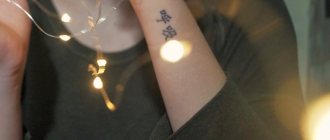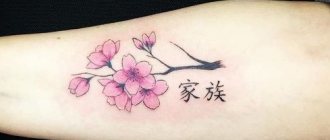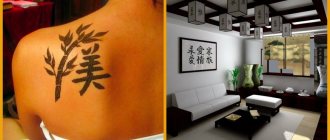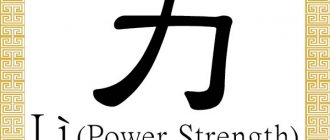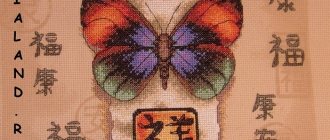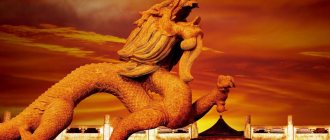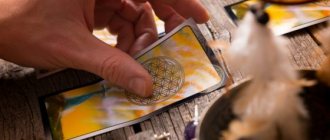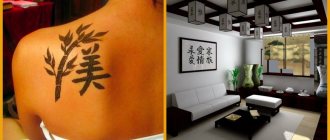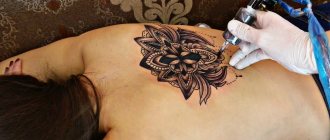The mysterious and diverse Chinese language has always aroused interest among Westerners. For the first time, sailors who arrived in China on merchant ships began to get tattoos with hieroglyphs on their bodies. These mysterious and attractive images continue to be in high demand. This article details popular Chinese characters for stylish tattoos and reveals their meaning.
Interesting fact: Ancient Chinese has more than 50,000 characters. Knowledge of three thousand of them will allow you to read any Chinese literature.
Every average Chinese knows the meaning of at least one and a half thousand characters.
The meaning of Chinese characters in the art of tattooing
Chinese characters have been used for tattoos since ancient times. The significance of such an image on the body and the attitude towards it in society has changed. Tattoos with hieroglyphs-pictograms were used by priests in special rituals , including to impart qualities to their owner and even for a kind of treatment.
During the Confucian period, a ban on tattoos was introduced.
At that time, their application was associated with “causing damage” to the human body, which was recognized as a divine gift. In the Middle Ages, tattoos were made on the face of criminals in order to warn respectable citizens that they were facing a criminal person (the more often a person was sent into exile, the more inscriptions were made).
This punishment was called body piercing and the memories of it are still alive in Chinese society, so it is not customary to apply hieroglyphs to the face.
But even when tattoos were a sign of social outcasts, the genre continued to develop and was popular. The 12th-century adventure novel River Backwaters (水滸傳) is replete with characters of tattooed “noble rebel bandits” who were also martial artists.
One of the legendary heroes of the book wore a tattoo of a dragon that wrapped itself around his body 9 times, and another had tattoos of beautiful flowers. Another popular book, The Tale of Yue Fei, changed the concept of tattoos as belonging to a criminal environment or to the lower class.
The owner of a sacred tattoo with the hieroglyphs “perseverance, loyalty and devotion to the country” becomes the main character of the novel - commander Yue Fei from the wealthy Song dynasty. His mother decides to give Yue Fei a tattoo in order to guide her son on a certain path in life and as a talisman.
The real historical prototype of the hero of the novel (a 12th century commander) gained people's love as a person who contributed to the restoration of the professional army of the south and the development of martial arts. Perhaps this fact is associated with the particular popularity of hieroglyph tattoos among warriors and martial artists, which has survived to this day.
Chinese tattoo hieroglyphs and pictures in oriental style became popular among Europeans in the 20th century due to the presence of US and British ships in Hong Kong. Sailors were regular customers of Chinese tattoo parlors, but not only because of their love for exotic things and talismans. Tattoos on the body of naval personnel were recorded and were supposed to help identify the body in the event of death.
Fortunately, most of the sailors returned home alive, taking with them the original “Chinese souvenir” in the form of a tattoo.
In modern China, tattoos are associated with several concepts: fashion, talisman, martial arts, underground, crime. At the same time, criminal tattoos are, for the most part, pictures, the meaning of which is known only to a narrow circle of people, and it is almost impossible to apply them in a regular salon.
Fashionable tattoos with hieroglyphs, often written in a traditional style, are applied by young people under 30 as decoration and to emphasize individuality. Tattoos are sometimes accompanied by images even in 3D, and Europeans like this kind of graphics on the body more.
The names of the zodiac signs according to the Chinese horoscope and even lines from poetry are popular.
As a talisman, hieroglyphs are applied to certain parts of the body (various areas of the arms, legs, collarbone, neck, back) since the location of the inscription is important for activating the action of the tattoo. Such symbols are designed to attract wealth, love, happiness, health into the life of the wearer, and even get rid of bad habits.
Among martial arts masters, both hieroglyphs with individual words, mottos, and images of animals whose qualities the athlete wants to acquire are popular. A tattoo can carry information about a martial arts school or be associated with the “pseudonym” of the master.
Many musicians and artists who create works of contemporary art cover their bodies with a whole carpet of tattoos. The attitude towards tattoos in the artistic community can be expressed in the words of the fashionable Chinese artist Zhuo Dan Ting, who became the first female owner of a famous tattoo art studio in Shanghai:
“...it is a form of art that can be worn and seen every day...”
Phrases in Chinese
Before learning spoken Chinese, you should definitely understand the rules of pronunciation. Words that are identical in spelling, but have different tonality (a line above the vowel) can also have different meanings. Tones can be as follows:
- a horizontal line means even intonation;
- the rising line is used in interrogative sentences;
- the tick-shaped curve shows somewhat variable intonation;
- The falling slash is used for exclamations.
A simple rule will help you clearly tell your interlocutor everything that is required. It is worth considering that the pronunciation of phrases may vary depending on the dialects of a particular city or even region. The table shows the most common phrases, or rather Chinese characters with translation.
| № | Writing | Translation |
| 1 | 你好 | Hello! |
| 2 | 再见 | Goodbye! |
| 3 | 谢谢 | Thank you! |
| 4 | 不客气 | Please! |
| 5 | 对不起 | Sorry! |
| 6 | 没关系 | It's OK |
| 7 | 请问,到 | Please tell me how to get there |
| 8 | 请问,厕所在哪里? | Tell me please, where is the toilet? |
| 9 | 请给我们拍一照 | Please take a photo of us |
| 10 | 多少钱? | What is the price? |
| 11 | 太贵了!来便宜点儿 | Very expensive! Let's go a little cheaper. |
| 12 | 我把这个试一下,好吗 | Can I try it? |
| 13 | 试衣间在哪里? | Where is the fitting room? |
| 14 | 我需要大一点儿 | I need a larger size |
| 15 | 我需要小一点儿 | I need a smaller size |
What does the location of the tattoo indicate: on the leg, arm, shoulder, back, stomach
Chinese characters for tattoos should not only be chosen with a deep understanding of the meaning of the symbol, but also located on the wearer’s body in certain places in order to bring the desired effect.
| Tattoo location | Symbols | Influence, significance |
| On the legs (ankle, shin, thigh). | Masculine : luck, strength. Women's : beauty, health. | Provoke the wearer to take any action. Activate masculine energy. Amulet (on the right leg). |
| On the arms (shoulders, forearms, wrists (inside or outside)). | Masculine : strength, courage, happiness, double happiness, wisdom, wealth, prosperity, bamboo (symbol of growth), hieroglyphs with the names of animals (tiger, dragon). Feminine : symbols of love, harmony, dream, happiness. | Allows a person to receive those qualities, feelings, benefits that the hieroglyph symbolizes or that the bearer of the tattoo would like to receive from life. |
| On the back (along the spine, on the shoulder blade or on the lower back.) | Masculine : strength, courage, well-being, mottos and sayings, names of animals with symbolic meaning. Women's : beauty, health, love, eternal love, peace, sayings. | Protection from external adverse influences. Also, the presence of an image on the back indicates a desire to demonstrate to others one’s strength and position. |
| On the stomach. | Masculine : wishes, mottos, money (錢), prosperity, strength. Women's : money, love, beauty. | They are quite rare and indicate specific material aspirations of the wearer. Limit your social circle. |
The meaning of double happiness
Unlike the “happiness” hieroglyph, the power of the “double happiness” symbol is more powerful and effective. He is able to fulfill all the desires and undertakings of not only one person, but also a group of people united by one desire. To attract success in business and creativity, place the hieroglyph in the north of the room, and the result will not be long in coming. The image of double happiness in the southwest helps to strengthen friendship, acquire new friends and like-minded people. The symbol helps to conceive a child if you energize the bed, replenish your wallet if you put the hieroglyph “happiness” in it, attract new opportunities and implement ideas. The image of double happiness can be presented as a gift to relatives and friends. It is important to give it with sincere and pure intentions.
Tattoo color
Traditionally, Chinese characters for tattoos can be chosen in a tattoo parlor in a black version, but there are also images using color, the so-called “pure” colors, of which there are 5 in Chinese culture.
Each color has its own symbolic meaning that must be taken into account:
- Blue-green (the Chinese have one color) - symbolizes wind , embodies the element of wood, the tendency to growth and development. The green hue is associated in Chinese culture with the birth of new life. Blue-green is considered the most “fickle color” and can mean both the color of the sky and wisdom, and the element that brings destruction.
- Red is the color of fire and sun. Symbolizes joy, upward movement. The power of the sun and fire is capable, according to the inhabitants of heaven, of scaring away evil, protecting, and bringing harmony and joy to the house. Red is associated with good omens, success, celebration, profit, vitality, enthusiasm.
- Yellow represents the element of earth and its associated properties: fertility, constancy, stability, inviolability, eternity. Yellow is the color of gold, and as a result, success and prosperity.
- White in Chinese culture is associated with the metal element and with the completion of the cycle (autumn), going beyond the world of the living. The inconsistency of the symbols associated with white is caused by the fact that it was both the color of mourning and the color of amulets against the inhabitants of the other world.
- Black is associated in traditional Chinese culture with the element water , associated with mystery and mysticism, the unknown, the ability to remember everything and change. Therefore, color symbolizes wisdom, the desire for knowledge, immersion in the study of the secrets of existence.
In tattoos, colors are used to give greater power to images and hieroglyphs (for example, there may be a red outline of symbols to reinforce their auspicious meaning).
Signs filled with chi energy
There are other runic characters in the Chinese language: “love”, “happiness”, “luck”, “wealth”, “longevity”, “health”. Such symbols are often applied to furniture or the interior of rooms in order to attract corresponding benefits to the inhabitants of the house.
For example, the hieroglyph “love” promotes harmony and peace in love relationships, eliminates conflicts, and strengthens family ties. “Luck” ensures success in all matters, expands the horizons of possibilities, and contributes to business development. The hieroglyph is usually drawn on workplaces, office or study walls. “Wealth” attracts money, material wealth, increases income and profits, and creates appropriate energy in the home and office. The hieroglyph “longevity” can ensure long and happy years of life; it is usually applied to the walls of the bedroom. The symbol of “health” brings good health to all household members, excellent mood, and promotes the recovery of the sick. All these hieroglyphs, despite the benefits contained in them, are based on the most important and important symbol of “qi” - vital energy, which is the catalyst for all living things.
Ideas for tattoos: hieroglyphs and their translation
Most symbols for tattoos are auspicious hieroglyphs from Feng Shui, which are used to wish good things or attract good luck.
Video about the meaning behind popular Chinese characters used in tattoos:
Happiness
幸福consists of two parts, each of which can be depicted separately, as it has its own meaning and sound. The first character, 幸 (shin) means happy, prosperous, and the second - 福 (fu) means “blessing”, “joy”, “prosperity”, “peace”. That is, the hieroglyph reflects the Chinese idea of happiness as God’s blessing for well-being in all areas of life.
The image is intended to bring happiness and good luck to the wearer precisely in the area in which he asks from higher powers.
Great happiness
喜喜is a double-written character for “joyful” (si), which also means “cheerfulness.” It is considered a powerful talisman that brings growth in various areas, from the birth of children to good luck in business. It is recommended for application as a talisman for success in family relationships or matters related to partnership, since the sign is paired.
Love
愛 (ai) consists of four components: claw, roof, heart, paws. That is, in it you can find a symbolic description of love: “a feeling that pierces the heart, settles in it and does not allow it to escape.” The image is used as a talisman to attract love, find a soul mate, harmony and joy in family life, and strengthen marriage.
Eternal love
永愛 (yong ai) consists of two parts. The first element means “long”, “endless”. This element contains the key water with the meaning current long. The hieroglyph is used as a talisman to strengthen love and friendship, gives mutual understanding to partners, and brings a new wave of feelings into the relationship between spouses.
Wealth
富 (fu) contains parts such as abundance and building, that is, it depicts prosperity in the house. This hieroglyph attracts not only material values, but also spiritual wealth associated with gaining knowledge about life. It is considered a good talisman for success in business and business well-being.
Material wealth is also symbolized by the character 錢 (money), which is also used to attract wealth.
Prosperity
繁荣 (fanrong) is a character consisting of two parts, the first character means “numerous”, “in large numbers”, the second character means “glory”, “honours”, “popularity”. It is used as a talisman to attract not only material well-being, improvement in business, but also the accompanying honor and respect, good fame about a person and his business.
The stylized spelling of the first character 繁 is often used to protect against failure in any area.
Abundance
The hieroglyph resembles a bowl of ears of corn (a symbol of a rich harvest). This image is used to attract the energy of growth in any area. You can add a second symbol with the image of the “object of desire”, which will enhance the effect of the sign. The hieroglyph is also a talisman against poverty and decline.
Force
力 (li) – looks like a strong hand pointing downwards. It is believed that the symbol fills its wearer with internal energy and vigor, and gives confidence in oneself and one’s actions. A talisman tattoo will also give you strength to implement creative plans and give you new ideas.
Joy
樂 (yue, le) - interpreted not only as “joy”, but also as “pleasure”, “fun” and “music”. The talisman is designed to fill the wearer with positive emotions, help to live easily, and cure sorrows.
Health
The character 健康 (jiang kang) brings the greatest value to the owner - good health. Helps solve problems with poor health, overcome mental crises. Health in the broadest sense of the word.
You can find the first symbol separately as a wish for recovery during treatment.
World
The Chinese symbol 和 (Heipin) , which means “peaceful,” “good-natured,” calm,” is applied to give a person peace of mind and also as a talisman for good, smooth relationships with others.
beauty
The symbol 美 (mei) is very popular as a tattoo for women , which is often applied along with the image of flowers that represent purity. The talisman is designed to provide the owner with beauty and health. Previously, the hieroglyph had the meaning “peaceful”, as it combined the image of a man and a lamb (literally “meek as a lamb”).
Independence
獨立 (du li) literally means “standing apart”, free from force, influence, authority. There are stylized writing options. Used as a talisman for liberation from addiction, bad habit.
Courage
The symbol 勇 (yong) is “courage” and combines the elements “brave” on top and “strength” on the bottom. The tattoo gives courage, perseverance and bravery to its owner. Often marked with the symbol 气 (xi), representing energy.
Dream
The hieroglyph 夢 (men) - “dream” is one of the most popular symbols for drawing, as it symbolizes movement towards a dream. But there is another meaning of the sign: “dream”, “illusion” and a hidden message - to take the transience and impermanence of life for granted.
Fulfillment of desires
如意 (ryuyi) literally means “quality of desire.” The message contained in this symbol on the tattoo reads: “May your dreams come true!” In Feng Shui, it is believed that by giving images of this hieroglyph to his friends, a person wishes them the fulfillment of all their aspirations and in return receives the fulfillment of their hopes.
A little about Chinese writing
Chinese characters are considered the most ancient and are used not only in their homeland, but also in Japanese and Korean writing. Even before 1945, Chinese writing was widely used in Vietnam. The number of hieroglyphs is not reliably known to anyone, since they are systematically and continuously modified. Every day, people all over the world use at least several thousand hieroglyphs. The approximate number of all existing signs is 50,000 pieces. Statistics say that a thousand everyday signs cover approximately 92% of all printed materials.
Everyday people all over the world use at least several thousand hieroglyphs
The approximate number of all existing signs is 50,000 pieces
Statistics say that a thousand everyday signs cover approximately 92% of all printed materials
In China, it is considered normal to know 2 thousand characters.
- Simple signs have one dash, for example:一read and, means - one.
- The hieroglyph with the largest number of lines consists of three characters:龍, read lun, symbol - dragon.
Interesting! Researchers of writing are very surprised by the fact that hieroglyphic writing does not depend on the dialect at all. For example, if you need to say something to your interlocutor from China, and you write a hieroglyph on paper, then every resident of this country will understand you, regardless of which province he came from.
In China, it is considered normal to know 2 thousand characters
Beautiful ancient Chinese pictures for tattoos
Residents of the Middle Kingdom are more willing to get tattoos of images than inscriptions. Tattoos with animals, flowers, birds, mythological creatures and abstract symbols are popular among the Chinese.
Each image symbolizes certain concepts:
- Phoenix is a symbol of fortitude and desire to live.
- The dragon represents power and might.
- Tiger – dignity, power, deceit.
- The turtle and the snake are a symbol of thoughtful comprehension of truths.
- Lotus is a symbol of purity and wisdom.
- Carp is a symbol of wealth.
- Monkey – strength, courage and luck.
- Yin and yang are harmonies.
Keys in hieroglyphs
As could be understood from the analysis of the composition of some of the hieroglyphs above, simple symbols can be part of complex ones (for example, strength and courage 力 and 勇). Chinese characters are classified according to elements that classify a word into the category of some objects or concepts, that is, according to keys.
In total, in the traditional system there were 214 such “keys” (they are also called radicals), in the modern version there are 201. The radicals “man” 人 and “strength” 力 were often found in symbols for tattoos. You can find the symbols in the summary table of hieroglyphs.
Chinese alphabet
The alphabet of any nation has its own distinctive features:
- The alphabet is a specific sequence and collection of symbols. Syllables and words are built from them.
- The number of letters is limited and cannot be added or reduced.
The Chinese set of characters completely excludes these features. There are no letters in the language. And keys and pictograms can represent not only a letter, but also a word. Sometimes they describe an entire sentence. And the number of hieroglyphs does not have an exact number at all, as it is constantly changing. And the number of elements goes into tens of thousands.
Any hieroglyph, as is known, consists of a certain number of elements. The number of the main ones reaches several thousand, but there are those that are used much more often. The element itself does not carry any meaning. The basic ones include the following:
- vertical line;
- horizontal line;
- upward stroke (ascending);
- dot;
- hook;
- broken line.
From such simple elements beautiful characters of the Chinese alphabet are built. Chinese philosophers have always compared written symbols to life. This was said back in the philosophy of Qi. Some are updated over the years, others are simply lost, since their value is no longer used. Over the years, new hieroglyphs may appear. And this will continue for many more years.
China does not have an alphabet like other countries. Everything is written in hieroglyphs, even new foreign words. But there is still a system of so-called romanization of Chinese writing. It's called Pinyin.
Pinyin contains 26 letters. And in no language can you get 23 consonants and 24 vowels from so many beech sounds. It is this writing that is often used in smartphones to write messages faster.
Most scholars are of the opinion that the Chinese alphabet simply does not exist. And Pinyain is simply an auxiliary alternative for simplifying written communication using gadgets. It was developed relatively recently - in the late 50s of the last century.
Preparation for tattooing
To perform tattoos of hieroglyphs, it is recommended to choose a master who specializes in the oriental style so that the outline of the symbols is accurate. Before applying the image, you must select a sketch from the proposed options or order an individual drawing from the master.
You can come with a photo of the desired tattoo.
In order not to remove the tattoo, sometimes a temporary version is made at the request of the client. If necessary, depilation is performed before application. You should not take blood pressure-raising medications or drink alcohol before getting a tattoo.
On the neck and head
According to statistics, most often hieroglyphs are tattooed on the neck. I think many people have met people with the symbol of the Chinese horoscope stamped on this place. You can rarely find such tattoos on the head itself. The only exception is a woman's favorite place - behind the ear.
Also, facial tattoos have become fashionable lately.
You can already meet a character with an oriental symbol above the eyebrow or under the eye.
How is a tattoo done, how long does the procedure take?
Immediately at the beginning of the procedure, the skin is treated with a special disinfectant (solution or gel). Next, local anesthesia is examined - an aerosol is sprayed onto the skin. Then the drawing from the sketch is transferred to an area of the body using special paper.
Working time depends on the complexity of the image, the number of characters, and the style of graphics. The need for additional pain relief is also discussed with the specialist in advance. Tattoos are done quickly. The procedure is performed with a special machine with thin disposable needles. Caps for paints are also used 1 time.
The master must wear sterile gloves!
Application options
Of course it sounds great: “When a tattoo is applied to the neck, the aura is cleansed, the “cone” rises, and the chakras open.” But it is better to be guided by other criteria.
If you want others to see and know about the tattoo, if you want to say something with it, to attract attention, do it in an open place.
If you want to please yourself and a loved one, but are not ready to advertise your “painting” to others, do it where it is easy to cover it with clothes.
Everything here is purely individual, depending on the person himself, the choice of sketch, style. Some designs look good on the arm, others on the chest or thigh.
Think about it, weigh it in any case, the choice will be yours.
Skin care after tattooing
After tattooing, local redness of the skin occurs or blood may appear. Healing after the procedure usually takes 2 weeks. At this time, there is no need to injure the skin with excessive sunbathing (or solarium), mechanical or chemical influences. You can treat the skin with a delicate cream with antiseptic properties.
Chinese characters for tattoos are symbols that help improve fate, and not just pretty pictures
If after this period there is pain and inflammation, you should consult a doctor.
What Chinese style tattoos should you not get?
Symbols for tattooing should be chosen, avoiding hieroglyphs with the meaning: decline 下降, illness 病, death 死亡. also not recommended to depict numbers (especially 4!) and symbols of subordination. You shouldn’t get a tattoo with a name in Chinese if you don’t have reliable information about what each graphic symbol means individually.
Chinese characters used for tattoos, in compliance with ancient traditions when applied, can add luck and prosperity to a person’s life.
Article design: E. Chaikina
